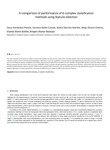Mostrar o rexistro simple do ítem
A comparison of performance of K-complex classification methods using feature selection
| dc.contributor.author | Hernández-Pereira, Elena | |
| dc.contributor.author | Bolón-Canedo, Verónica | |
| dc.contributor.author | Sánchez-Maroño, Noelia | |
| dc.contributor.author | Álvarez-Estévez, Diego | |
| dc.contributor.author | Moret-Bonillo, Vicente | |
| dc.contributor.author | Alonso-Betanzos, Amparo | |
| dc.date.accessioned | 2017-02-10T17:10:45Z | |
| dc.date.issued | 2016-01-20 | |
| dc.identifier.citation | Elena Hernández-Pereira, Veronica Bolón-Canedo, Noelia Sánchez-Maroño, Diego Álvarez-Estévez, Vicente Moret-Bonillo, Amparo Alonso-Betanzos, Information Sciences, Information Sciences 328 (2016), pp. 1–14 | es_ES |
| dc.identifier.issn | 0020-0255 | |
| dc.identifier.issn | 1872-6291 | |
| dc.identifier.uri | http://hdl.handle.net/2183/18099 | |
| dc.description | The final publication is available at ScienceDirect via http://dx.doi.org/10.1016/j.ins.2015.08.022 | es_ES |
| dc.description.abstract | [Abstract] The main objective of this work is to obtain a method that achieves the best accuracy results with a low false positive rate in the classification of K-complexes, a kind of transient waveform found in the Electroencephalogram. With this in mind, the capabilities of several machine learning techniques were tried. The inputs for the models were a set of features based on amplitude and duration measurements obtained from waveforms to be classified. Among all the classifiers tested, the Support Vector Machine obtained the best results with an accuracy of 88.69%. Finally, to enhance the generalization capabilities of the classifiers, while at the same time discarding the existing irrelevant features, feature selection methods were employed. After this process, the classification performance was significantly improved. The best result was obtained applying a correlation-based filter, achieving a 91.40% of accuracy using only 36% of the total input features. | es_ES |
| dc.description.sponsorship | Xunta de Galicia; 09SIN003CT | es_ES |
| dc.description.sponsorship | Ministerio de Economía y Competitividad; TIN2013-40686P | es_ES |
| dc.description.sponsorship | Ministerio de Economía y Competitividad; TIN2012-37954 | |
| dc.description.sponsorship | Xunta de Galicia; GRC2014/35 | |
| dc.language.iso | eng | es_ES |
| dc.relation.uri | http://www.sciencedirect.com/science/article/pii/S0020025515006088 | es_ES |
| dc.rights | Atribución-NoComercial-SinDerivadas 3.0 España | es_ES |
| dc.rights.uri | http://creativecommons.org/licenses/by-nc-nd/3.0/es/ | * |
| dc.subject | Feature selection Machine learning | es_ES |
| dc.subject | K-complex classification | es_ES |
| dc.title | A comparison of performance of K-complex classification methods using feature selection | es_ES |
| dc.type | info:eu-repo/semantics/article | es_ES |
| dc.rights.access | info:eu-repo/semantics/embargoedAccess | es_ES |
| dc.date.embargoEndDate | 2018-01-20 | es_ES |
| dc.date.embargoLift | 2018-01-20 | |
| UDC.journalTitle | Information Sciences | es_ES |
| UDC.volume | 328 | es_ES |
| UDC.startPage | 1 | es_ES |
| UDC.endPage | 14 | es_ES |
| dc.identifier.doi | 10.1016/j.ins.2015.08.022 |
Ficheiros no ítem
Este ítem aparece na(s) seguinte(s) colección(s)
-
GI-LIDIA - Artigos [50]






